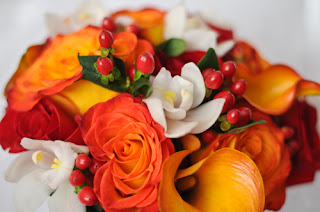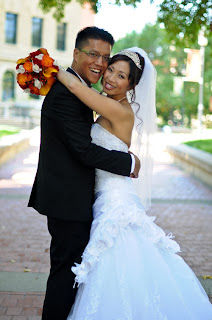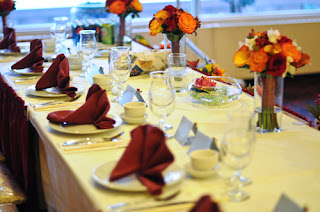No other couple to date has so embraced their color theme like these
two. Vibrant fuchsia pink and midnight black created a tremendous impact
that perfectly reflected this couple. The bouquets and boutonnieres
featured pink spotted feathers and black marabou and spider Dahlia's.
Wedding Planner: Inspired Occasions
Photographer: TLaw Photography
Blog created by Modern Petals - Your local Calgary Florist. We specialize in unique and creative everyday and wedding floral design. Check out our site at www.modernpetals.com.
-
-
I would never have considered myself as a pink person, I typically lean
towards warm earth colors, but there is just something about a delicate
soft pink flower or a bold in your face fuchsia bloom that makes me
smile. It is the second most popular wedding flower color after white
due to its' incredibly wide range of flower choices and bloom color. Now
while there may be more pink flowers than the ones shown here, these
are the one I have found to be most reliable and hardy. One of the
flowers that offers the broadest range of pink shades is the Gerbera, I
show here a hot pink and a light pink, but they come in dark rich
pomegranate pinks to the palest blush pinks and everything in between.
The choice is incredible. As for the other flowers some are seasonal.
In the Spring - Tulips, Hyacinth and Nerine Lilies show up, then as we
move into late Spring the Peony's, Boronia and Heather arrive. When
Summer is in full bloom so are - Aster Matsumoto, Gladiola, Veronica,
Larkspur, Sedum, Astilbe and Celosia. All the other pink flowers are
available year round. Because of the color choice available pink flowers
can accent most any theme, soft and pretty for a vintage look to
bright and punchy for a rock and roll glam look. Pink, Pink, Pink there
is a reason it is so popular.

Blog created by Modern Petals - Your local Calgary Florist. We specialize in unique and creative everyday and wedding floral design. Check out our site at www.modernpetals.com.
Ahh Green, there is nothing quite like it to evoke the feeling of
something fresh and crisp. Green has been a rising trend and for good
reason. Some of the flowers that are available in green are not
available in any other color thus giving a feeling of exclusiveness.
Another great thing about the family of green flowers is the texture
that is available. These different textures can help to enforce certain
themes you may be considering. For example the soft and delicate
Alchemillia plays up a vintage theme, while the richly textured Celosia
accents an exotic marketplace vibe and the sleek lines of the Green
Goddess Calla are the perfect accessory to a contemporary wedding.
Another plus for green flowers is that most are available all year long.
The only exceptions are Celosia, Hanging Amaranthus, Buplerum and
Alchemillia, these are only available from late Spring through to early
Fall. So think of adding a bit of green to your wedding, you will be
happy that you did.

Blog created by Modern Petals - Your local Calgary Florist. We specialize in unique and creative everyday and wedding floral design. Check out our site at www.modernpetals.com.
I love it when a Bride comes in an knows exactly what she wants!!1
Katie knew what she was looking for right down to the number of stems
of flowers . It was great! She knew the look that they were going for
and had thought alot about it. The planning all came together and her
bouquets suited their personality and style perfectly.
Photographer: Lime Light Photography
Blog created by Modern Petals - Your local Calgary Florist. We specialize in unique and creative everyday and wedding floral design. Check out our site at www.modernpetals.com.
So last time I talked about Blue flowers and this
week I will broaden that color palette and introduce some gorgeous
purple flowers. In the purple family colors can range from misty pale
lavender, to pinky mauve, to true royal purple to inky black and plumy
purple, so creating an all purple bouquet or adding purple accents to
your wedding is fairly easy to do. I have not mentioned all the purple
flowers available as my focus is on sturdy flowers that can withstand a
busy wedding day and still look fabulous! Again, as with blue flowers,
some of the flowers in the purple family are seasonal. Flowers such as
Anemones and Agapathus are at there best in the Spring, while Veronica,
Phlox, Allium and Stocks are at their best in late Spring and early
Summer. Finally the late Summer Gladiola and Echinops are stunning.
While some of the above mentioned flowers are available outside of the
seasons mentioned, they are at their prime during the specified season.
One flower that is great in all the massed designs that we are seeing
this year is the Carnation. Now, I know, Carnations seem so 1980's, but
the new Moon Series variety in deep dark blacky purple is nothing short
of stunning. Massed together to form a big ball or unique head table
piece, they loose the old fashioned vibe and become trendy and unique.
The key is grouping them together in large numbers and keeping them
stmes short so you just see their gorgeous heads. For all the purple
lovers out there, embrace your color scheme and get some help from
Mother Nature.
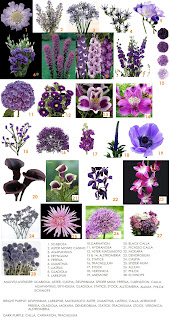
Blog created by Modern Petals - Your local Calgary Florist. We specialize in unique and creative everyday and wedding floral design. Check out our site at www.modernpetals.com.
Purple
was Kendra and Geoff's color and her unique bouquet really showed it
off. Her bouquet featured Moon Series blackish purple Carnations as the
base, Then we added Picasso posy Callas and individually wired Mokara
blooms scattered on top and threaded onto thin silver wire to create a
cascading look.
Photographer: Edward Ross Photography
Blog created by Modern Petals - Your local Calgary Florist. We specialize in unique and creative everyday and wedding floral design. Check out our site at www.modernpetals.com.
When planning a wedding there are so many choices to make and one of the
hardest can be a color scheme for the wedding. But once a color scheme
has been chosen then you can really get going and things will start to
fall into place. Something to keep in mind is the color availability of
flowers, not all flowers come in all colors and some colors are harder
to find in nature than others.
Blue is one of them. For a true blue flower you are limited to a few
stems, but if you broaden your scheme a bit the color palette has a few
other choices. For those of us here in Calgary the blue flowers
available are shown below, however, not all are available all year long.
Brodiea and Cornflower are available in the late Summer, while Hyacinth
is available in the early Spring. The remaining flowers such as
Hydrangea, Delphinium and Iris are available all year long but the shade
of color may be slightly different depending on the season. Beware of
dyed blue roses and orchids as they not only don't look natural but dye
can come off on your hands or worse still on your dress if the blooms
get crushed slightly or rubbed the wrong way. Stay clear of these for
your bouquets, boutonnieres and corsages. You can introduce them into
your ceremony or reception pieces, but our preference is to use some of
the naturally blue flowers below or punch up the blue color with fun
accessories like beads, gems, pins or ribbon. So for all the Brides out
there that love blue - relax, it's doable, just be a bit flexible with
your florist and they can put together something stunning in blue!

Blog created by Modern Petals - Your local Calgary Florist. We specialize in unique and creative everyday and wedding floral design. Check out our site at www.modernpetals.com.
The rich fall tones, chosen by Carol and
Vincent were perfect for this early September wedding. I love how the
Bridesmaids coral colored dresses were a welcome change from the typical
darker toned dresses chosen for a Fall wedding and really added a
bright pop of color. The bouquets of Circus and Freedom Roses were
accented with Hypericum Berries and for Carol's bouquet a few blooms of
White Cymbidium Orchid and orange Posy Callas.
Photographer: C Koop Photography
Blog created by Modern Petals - Your local Calgary
Florist. We specialize in unique and creative everyday and wedding
floral design. Check out our site at www.modernpetals.com.
SueEllen and Cory wanted a very classic
and elegant wedding and the all ivory flowers for the wedding party
helped to pull this theme together. For the reception hits of purple
were added for a touch of color.Vendella Roses and crystal centered
Stephanotis combined to create the Brides bouquet.
Blog created by Modern Petals - Your
local Calgary Florist. We specialize in unique and creative everyday and
wedding floral design. Check out our site at www.modernpetals.com.
This varied group of orchids includes plants from any environments, some
come from hot and dry areas while other grow in less severe conditions.
LIGHT
Most Oncidium thrive with one to several hours of sunlight a day.
Generally thicker leaved plants can stand more light. In the home, east,
shaded south and east windows are ideal.
TEMPERATURE
Temperatures for Oncididum should usually be 55-60F at night and range
from 80 -85F or more during the day. Although higher temperatures force
faster vegetative growth, higher humidity and air movement must
accompany higher temperatures, the recommended maximum being 100F.
WATER
Generally plants with large fleshy roots and/or leaves need less
frequent watering than thin leaved and/or rooted plants. Plants should
be thoroughly watered and not watered again until nearly dry through the
pot. In the heat of summer in a dry climate like Calgary, this may be
every few days and in the winter here, it may even be every 10 days.
Also the type of potting media will determine the frequency of watering.
Pots with moss generally take longer to dry out than plants potted in
bark. Water only in the morning so the leaves are dry by nightfall to
avoid rot from occurring on the leaves.
HUMIDITY
Oncidium require humidity between 30-60%. In the home, set the plants on
trays of gravel, partially filled with water so that the pot never sits
in water or have a humidifier in the room. Mist the plant in dry
climates or during dry weather in the morning only. Misting is not
required for fleshy leaved types.
FERTILIZER
Use a fertilizer high in nitrogen (grow fertilizer) from about March to
September and a fertilizer high in phosphorus (bloom fertilizer) the
rest of the year. When in active growth plants need fertilizer every 2
weeks and when not growing, once a month. Thorough flushing with clear
water every month is recommended to prevent build-up of fertilizer
salts.
POTTING
This is best done in the Spring after blooming. Potting is usually done
every 1 – 3 years. Mature plants can grow in the same pot until the
potting medium starts to decompose, usually in 2 years. Root rot occurs
if plants are left in a soggy medium. A fine grade potting medium is
usually used for fine rooted plants and coarser mixes with large rooted
plants. To re-pot, remove the entire old medium from the roots, trim
soft/rotted roots and spread the remaining roots over a cone shape of
medium in the bottom if a new pot. Fill the rest of the pot with medium,
working it through the roots, so that the junction of the roots and the
stem is at the top of the medium. Keep plant shaded and humid , but
drier in the pot, for several weeks, to promote new root growth.
Blog created by Modern Petals - Your local Calgary Florist. We specialize in unique and creative everyday and wedding floral design. Check out our site at www.modernpetals.com.
Paphiopedilum, or slipper orchids, originate from the jungles of the Far
East and Indonesia. They are semi-terrestrial, growing in humus and
other material on the forest floor, on cliffs in pockets and
occasionally in trees.
LIGHT
Most Paphiopedilum prefer shady conditions. In the home, east, shaded south and east windows are ideal.
TEMPERATURE
Temperatures of the Paphiopedilum vary considerably, but most are
separated by the warm growing mottled leaf group and the cool growing
green leaf types. Warm types prefer 60-65F at night and 75-80F or more
during in the day, cool types prefer 50-60F at night and 75-80Fduring
the day. Although higher temperatures force faster vegetative growth,
higher humidity and air movement must accompany higher temperatures, the
recommended maximum being 100F
WATER
Water must be available to the roots constantly, since they have no
pseudbulbs, and therefore store most of their water in their leaves.
They need a moist medium – never soggy, but never dry either. Water once
or twice a week and water only in the morning so the leaves are dry by
nightfall to avoid rot from occurring on the leaves.
HUMIDITY
Paphiopedilum require humidity between 40-50%. In the home, set the
plants on trays of gravel, partially filled with water so that the pot
never sits in water or have a humidifier in the room. Mist the plant in
dry climates or during dry weather in the morning only.
FERTILIZER
Use a fertilizer high in nitrogen (grow fertilizer) from about March to
September and a fertilizer high in phosphorus (bloom fertilizer) the
rest of the year. When in active growth plants need fertilizer every 2
weeks and when not growing, once a month. Thorough flushing with clear
water every month is recommended to prevent build-up of fertilizer
salts.
POTTING
This is best done in the Spring after blooming. Potting is usually done
every 1 – 3 years. Mature plants can grow in the same pot until the
potting medium starts to decompose, usually in 2 years. Root rot occurs
if plants are left in a soggy medium. A fine grade potting medium is
usually used for fine rooted plants and coarser mixes with large rooted
plants. To re-pot, remove the entire old medium from the roots, trim
soft/rotted roots and spread the remaining roots over a handful of
medium in the bottom if a new pot. Fill the rest of the pot with medium,
working it through the roots, so that the junction of the roots and the
stem is buried ½” in the center of the pot. Keep plant shaded and
humid, but drier in the pot, for several weeks, to promote new root
growth. Do not over pot the average plant should have a 4-6” pot.
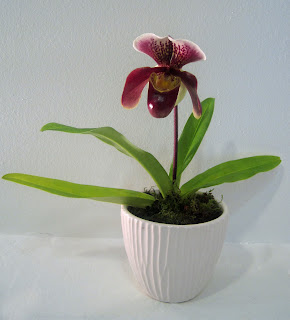
Blog created by Modern Petals - Your local Calgary Florist. We specialize in unique and creative everyday and wedding floral design. Check out our site at www.modernpetals.com.
Phalaenopsis, the moth orchid, is one of the best orchids for growing in
the home and is also a favourite with greenhouse growers. Well-grown
plants will flower for up to 6months!
LIGHT
Is easy to provide for Phalaenopsis, they grow easily in a bright window
with little or no direct sun. An east window is ideal in the home;
shaded south facing or west window are acceptable.
TEMPERATURE
Temperatures for Phalaenopsis should usually be above 60F at night and
range from 70 -85F or more during the day. Although higher temperatures
force faster vegetative growth, higher humidity and air movement must
accompany higher temperatures, the recommended maximum being 95F. Night
temperatures to 55F are desirable for several weeks in the fall in order
to initiate flower spikes. Extreme fluctuating temperatures can cause
buds to drop.
WATER
This is especially critical for Phalaenopsis, because they have no major
water storing organs other than their leaves, they must never
completely dry out. Plants should be thoroughly watered and not watered
again until nearly dry through the pot. In the heat of summer in a dry
climate like Calgary, this may be every few days and in the winter here,
it may even be every 10 days. Also the type of potting media will
determine the frequency of watering. Pots with moss generally take
longer to dry out than plants potted in bark. Water only in the morning
so the leaves are dry by nightfall to avoid rot from occurring on the
leaves.
HUMIDITY
This is important to the Phalaenopsis the recommended humidity is
50-80%. In the home, set the plants on trays of gravel, partially filled
with water so that the pot never sits in water or have a humidifier in
the room. Mist the plant in dry climates or during dry weather in the
morning only.
FERTILIZER
Use a fertilizer high in nitrogen (grow fertilizer) from about March to
September and a fertilizer high in phosphorus (bloom fertilizer) the
rest of the year. When in active growth plants need fertilizer every 2
weeks and when not growing, once a month. Thorough flushing with clear
water every month is recommended to prevent build-up of fertilizer
salts.
POTTING
This is best done in the Spring after blooming. Potting is usually done
every 1 – 3 years. Mature plants can grow in the same pot until the
potting medium starts to decompose, usually in 2 years. Root rot occurs
if plants are left in a soggy medium. To re-pot, remove the entire old
medium from the roots, trim soft/rotted roots and spread the remaining
roots over a handful of medium in the bottom if a new pot. Fill the rest
of the pot with medium, working it through the roots, so that the
junction of the roots and the stem is at the top of the medium. Keep
plant shaded and humid, but drier in the pot, for several weeks, to
promote new root growth.
Blog created by Modern Petals - Your local Calgary Florist. We specialize in unique and creative everyday and wedding floral design. Check out our site at www.modernpetals.com.
















